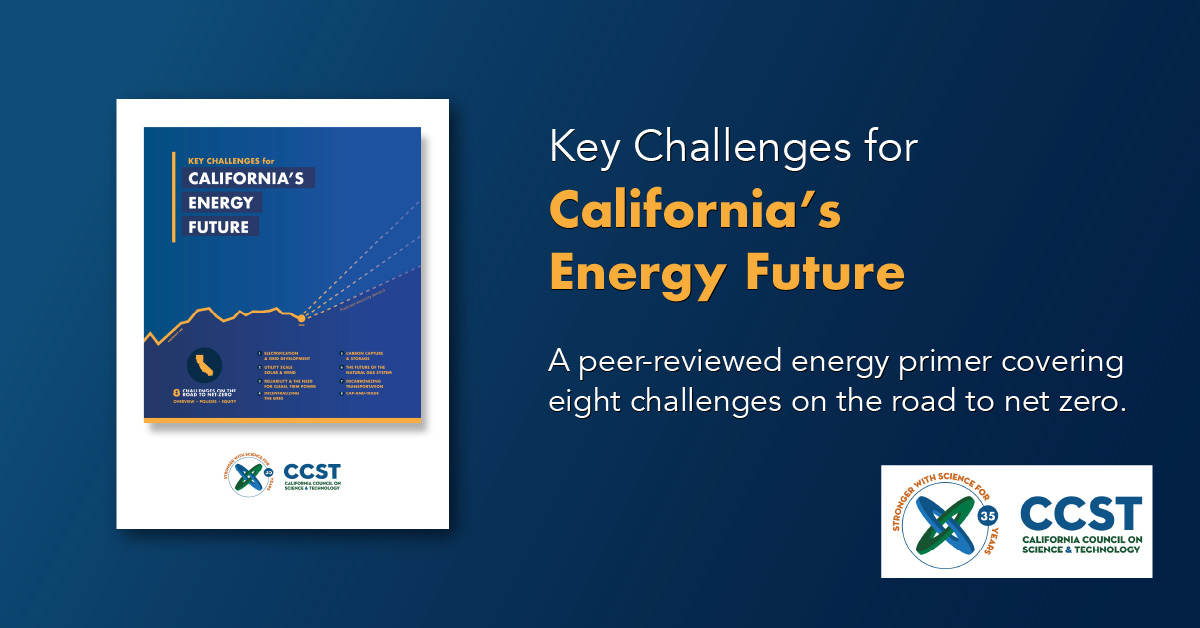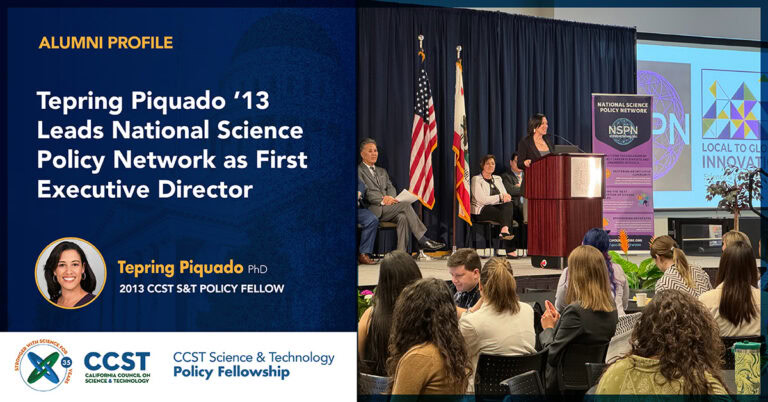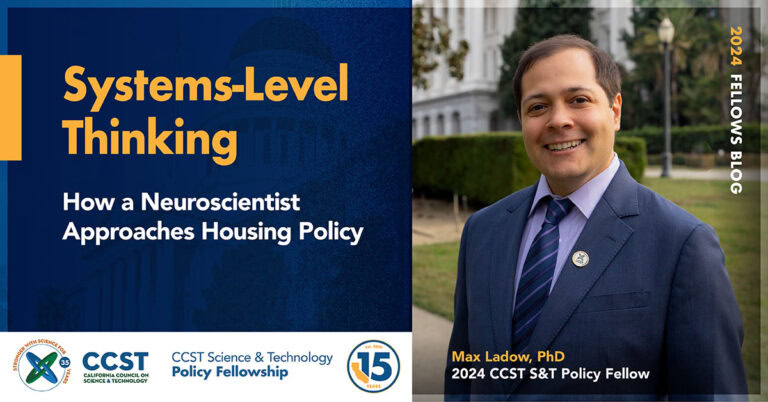Alumni Profile: Tepring Piquado ’13 Leads National Science Policy Network as First Executive Director
An Overview of California’s Energy Transition
June 26, 2023 | CCST Newsroom | Contact: Mikel Shybut

The following is an excerpt from CCST’s energy primer, Key Challenges for California’s Energy Future, featuring eight challenges on the road to a net-zero future. Key highlights are noted in bold. This overview section is authored by the Key Challenges for California’s Energy Future Steering Committee:
- Jane Long, PhD, Chair, Steering Committee, Independent Consultant & CCST Distinguished Expert;
- Michael Mastrandrea, PhD, Research Director, Climate and Energy Policy Program, Stanford Woods Institute for the Environment;
- Louise Bedsworth, PhD, Executive Director, Center for Law, Energy & the Environment, UC Berkeley;
- Colin Murphy, PhD, Deputy Director, Policy Institute for Energy, Environment, and the Economy, UC Davis;
- Arun Raju, PhD, Associate Research Engineer & Associate Director-Operations, Center for Environmental Research and Technology, UC Riverside.
Overview of California’s Energy Transition
by the Key Challenges for California’s Energy Future Steering Committee
The system of energy sources and applications we enjoy today has evolved over hundreds of years and has gone through multiple transformations over that period. Our complex energy system has many interacting technical and governance components. The current energy system emits greenhouse gases and causes other environmental impacts including air, water, and soil pollution. Low-income and communities of color disproportionately experience the negative impacts of our current energy system. Motivated by the dire and mounting risks of climate change and opportunities for a more prosperous, just, and healthy California, we are in the midst of a rapid transition of our energy system and other aspects of our economy that contribute to greenhouse gas emissions. Strong, rapid action guided by careful, evidence-based, and inclusive planning can help minimize the impact of climate change while securing a safe, prosperous, and equitable future for all Californians.
At a high level, decarbonizing energy has three fundamental elements:
- Maximize efficiency and electrify energy use across sectors to the greatest extent possible.
- Provide affordable, accessible, and reliable carbon-free electricity for a highly electrified economy.
- Decarbonize activities that cannot be electrified by using clean fuels, efficiency, conservation, and better land use planning and infrastructure.
We are now entering an era of fundamental, large-scale structural changes to the energy system, during which the choices we make must ensure that the future energy system has adequate capacity and is both reliable and cost effective.
Beyond the cost and performance of individual elements in the energy system, decision makers will also need to consider the full system implications and tradeoffs of technology investment choices for reliability, affordability, the environment, and equity.
During this period of transformational change over the next 2-3 decades, we must ensure that the up-front costs of this transition do not create barriers that prevent communities from accessing clean energy technologies.
Since the negative impacts of current fossil-fueled energy and transportation systems disproportionately fall on disadvantaged communities, there is a tremendous opportunity for this transition to help reduce historical inequity and injustice as well.
California has led the nation in innovative climate policy implementation. Over the past two decades, the state has developed and implemented a multipronged strategy that has achieved substantial progress toward reducing California’s greenhouse gas emissions, utilizing both sectoral policies and a Cap-and-Trade Program that operates across multiple sectors.i Through executive orders by the state’s Governors and extensive action by the Legislature, California has set bold and legally binding goals to achieve deep reductions in greenhouse gas emissions by 2030 and carbon neutrality by 2045.
In 2022, CCST staff consulted with policymakers and more than 30 experts across California’s preeminent academic and research institutions to identify energy issues that needed additional attention given policy conversations and their importance to California’s clean energy future. This process identified eight high-level key challenges, which are explored across the eight sections of this document. These sections highlight major challenges and opportunities, environmental justice and equity considerations, and resources for more information. In the future, other topics could be added to this list of eight as needs and relevance arise. Neither the set of topics chosen for sections nor the sections themselves are comprehensive, but are aimed at succinctly summarizing the status, challenges, and potential solutions.
This Overview describes a framework for California’s energy transition and highlights key issues that require attention. Of course, the complexities of this transition cannot be fully represented in a short Overview, nor can this document provide an exhaustive discussion of all relevant information. But it is intended to provide context for the subsequent sections that together can help inform policy making for sustainable, carbon-free, equitable energy for all Californians.
For many activities that currently rely on fossil fuel use, electrification provides the best strategy for developing a carbon-free energy system and is a fundamental strategy for meeting California’s climate goals.
Transportation and buildings have been the major focus of electrification to date. There are also electrification opportunities in other sectors including industry. This strategy is effective because it is possible to produce electricity from zero and near-zero greenhouse gas emission sources, and electrification solutions often offer efficiency gains compared to conventional fossil-fueled combustion.
In many cases, notably in transportation, more advanced and efficient technologies will replace emission-intensive ones. Investments in these technologies will pay dividends in the form of energy cost savings over the long run. In addition, the value provided by improved health from cleaner air and reduced climate change impacts will almost always outweigh the up-front costs. Attention must be paid to those who bear the costs to ensure equitable access and affordability.ii
Economic growth, population growth, and electrification are expected to increase demand for electricity. This demand can be tempered by continued attention to improving energy efficiency. California has abundant renewable resources. Rapid buildout of renewable energy, particularly utility-scale solar and wind generation, is a central strategy for California’s electricity decarbonization. In siting utility-scale solar and wind, the state must meet clean energy needs while also supporting other land use priorities such as agriculture, wildlife conservation, and recreation. Given this, siting and permitting can take far longer than is consistent with the envisioned buildout rate. These projects also often require concurrent development of transmission to interconnect with the electricity grid.
California has a good understanding of the magnitude of the state’s potential renewable energy resources, but it needs a realistic assessment of the magnitude of renewable energy that can be practically developed in the next decades given other environmental and social goals as well as legal, geographic, and transmission constraints. The next SB 100 Joint Agency Report, planned for release in 2025, will address the potential land-use impacts of its scenarios and is a step in that direction.iii
Solar and wind power are central to California’s carbon-free electricity strategy but present intermittency challenges from day to night and on a seasonal basis that can impact grid reliability if not effectively managed. California is deploying energy storage, demand response, and other strategies to manage the shorter-term intermittency of these resources. Additionally, California will need clean, firm power to manage the longer-term intermittency of renewable energy, for example, in winter periods when renewable energy supply is at a minimum. Clean, firm power—such as geothermal power, power from clean fuels, nuclear power, or gas with carbon capture and storage—can be available whenever needed and for as long as needed.
Ultimately, a diverse electricity generation portfolio that also includes clean, firm power would be more resilient to seasonal fluctuations and extreme weather events. As important as clean, firm power is, all the primary technologies have environmental impacts, drawbacks, and obstacles—like any power. California will need to make some difficult but critical decisions in deciding how to incorporate clean, firm power into its electricity sector planning.iv
As more vehicles and homes are powered by electricity, there will be increasing demand placed on California’s electricity grid. These new and increasing demands require upgrades and expansion of a grid that is already challenged by wildfires, extreme heat, and weather events. Both transmission and distribution infrastructure will need to be upgraded to accommodate additional demand and new energy resources. Microgrids have also been identified as one way to increase energy reliability and energy resilience, particularly for communities that are disproportionately burdened by grid disruptions. If effectively leveraged, distributed energy resources can enhance energy resilience for consumers and the grid at large.v
California needs careful thought about how to pay for the energy transition including necessary generation, energy storage, and upgrades to the grid. If many of these costs go into utility rates, load growth may not be adequate to keep costs affordable for consumers. Consequently, other funding mechanisms should be considered as well.
Electrification is almost always the best option for decarbonization, but some activities that currently use fossil fuels cannot easily be electrified. These include some forms of heavy-duty transport, aviation, and some industrial applications that either require high quality heat or fossil fuels as feedstocks for producing other materials (like plastics and chemicals). For most of these applications, the most straightforward decarbonization path would be to replace fossil fuels with clean fuels. These clean fuels all require energy for production and tend to be quite expensive, but they provide a high degree of flexibility. While few clean fuels are truly carbon neutral, many offer the opportunity to significantly reduce greenhouse gas emissions.vi
Hydrogen represents California’s primary option for clean fuel, including either “green” hydrogen produced using renewable energy to split water molecules, or “blue” hydrogen formed from methane and requiring sequestration of co-produced carbon dioxide (CO2).vii
Hydrogen is an indirect greenhouse gas. In evaluating hydrogen as a clean fuel, care should be taken to ensure that the excess warming due to hydrogen leakage in various applications does not offset the benefit of using hydrogen as a clean fuel.
Limited alternatives for clean fuel might include a) synthetic hydrocarbons formed in a process that captures carbon from biomass or the atmosphere; b) biofuels, including advanced processes that do not use edible crops as feedstock; c) renewable hydrogen produced by electrolysis or steam methane reformation with carbon capture; or d) ammonia. The costs and consequences of these or other options require evaluation. Typically, clean fuels are more expensive and limited in supply compared to their fossil alternatives.
Choices for clean fuel require a full evaluation of unintended consequences and tradeoffs. Each proposed fuel choice will need life-cycle analysis that includes assessment of indirect impacts. Clean fuels will be limited, so California needs a highest and best use plan for whatever clean fuel can be brought to market.
Carbon capture and storage may be an option for decarbonizing some industries such as cement manufacturing. The cement industry is a major contributor of greenhouse gas emissions resulting equally from the use of fossil fuels to heat limestone and the CO2 released from the heated limestone itself.viii
While greenhouse gas emissions have declined in most sectors, transportation emissions have remained relatively static due to continued growth in vehicle miles traveled (VMT). Reducing VMT—which can be accomplished by implementing more compact development patterns, supporting public transportation, and placing housing, jobs, and services in closer proximity to one another—is necessary to meet state greenhouse gas reduction targets. SB 375 (Steinberg, 2008) requires regional planning organizations to develop Sustainable Community Strategies that lower emissions by facilitating walkability, biking, public transportation, transit-oriented development, and other land use strategies. However, funding constraints, housing shortages, and the inability to enforce Sustainable Community Strategies—among other factors—hamper the State’s ability to reduce VMT.
Reducing VMT will require increased collaboration between state, local, and regional agencies to implement compact development patterns; funding for housing near jobs and services; investment in public transit, walking, and biking infrastructure; and robust public engagement.ix
California has the legal and regulatory framework in place to decarbonize energy in the state by midcentury. Electrification and innovation can vastly reduce the use of fossil fuels and increase energy efficiency across many sectors. A combination of renewable energy, energy storage, and clean, firm power can decarbonize electricity production. For any applications that present challenges for electrification, clean fuels, efficiency, conservation, and land-use planning become critical and primary strategies to help California achieve its climate goals.
California needs strong, rapid implementation coupled with careful and inclusive planning for a more prosperous, just, and healthy future.
Continue reading the full energy primer online. (or Download the full PDF)
——
i. See section 8. Cap-and-Trade.
ii. See section 7. Decarbonizing Transportation for electrification of the transportation sector. See 6. The Future of the Natural Gas System for building electrification. See 1. Electrification and Grid Development for the impact of electrification on California’s aging grid and the needs for grid upgrades to accommodate decarbonization.
iii. See sections 2. Utility-Scale Solar and Wind Development, 3. Reliability and the Need for Clean, Firm Power, and 1. Electrification and Grid Development.
iv. See sections 3. Reliability and the Need for Clean, Firm Power, 5. Carbon Capture and Storage, and 6. The Future of the Natural Gas System.
v. See sections 1. Electrification and Grid Development and 4. Decentralizing the Grid.
vi. See sections 6. The Future of the Natural Gas System, 5. Carbon Capture and Storage, 3. Reliability and the Need for Clean, Firm Power and 7. Decarbonizing Transportation.
vii. See sections 5. Carbon Capture and Storage and 6. The Future of the Natural Gas System.
viii. See section 5. Carbon Capture and Storage.
ix. See section 7. Decarbonizing Transportation.
###
About the California Council on Science and Technology
The California Council on Science and Technology is a nonpartisan, nonprofit organization established via the California State Legislature — making California’s policies stronger with science since 1988. We engage leading experts in science and technology to advise State policymakers — ensuring that California policy is strengthened and informed by scientific knowledge, research, and innovation.






